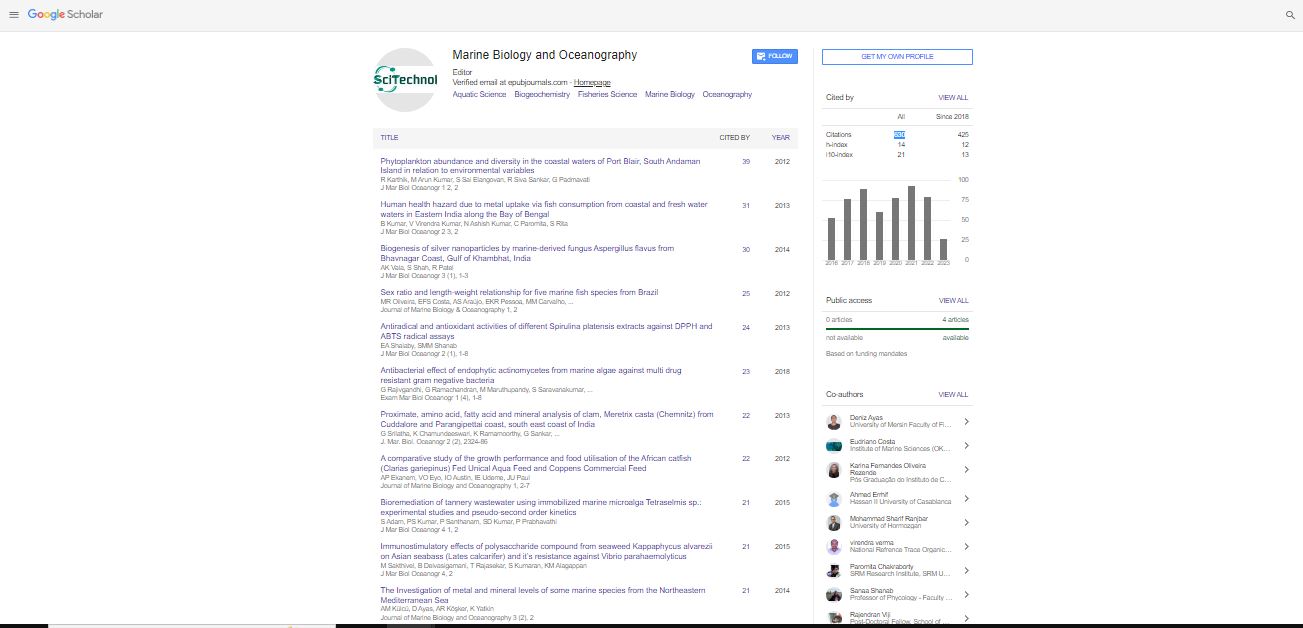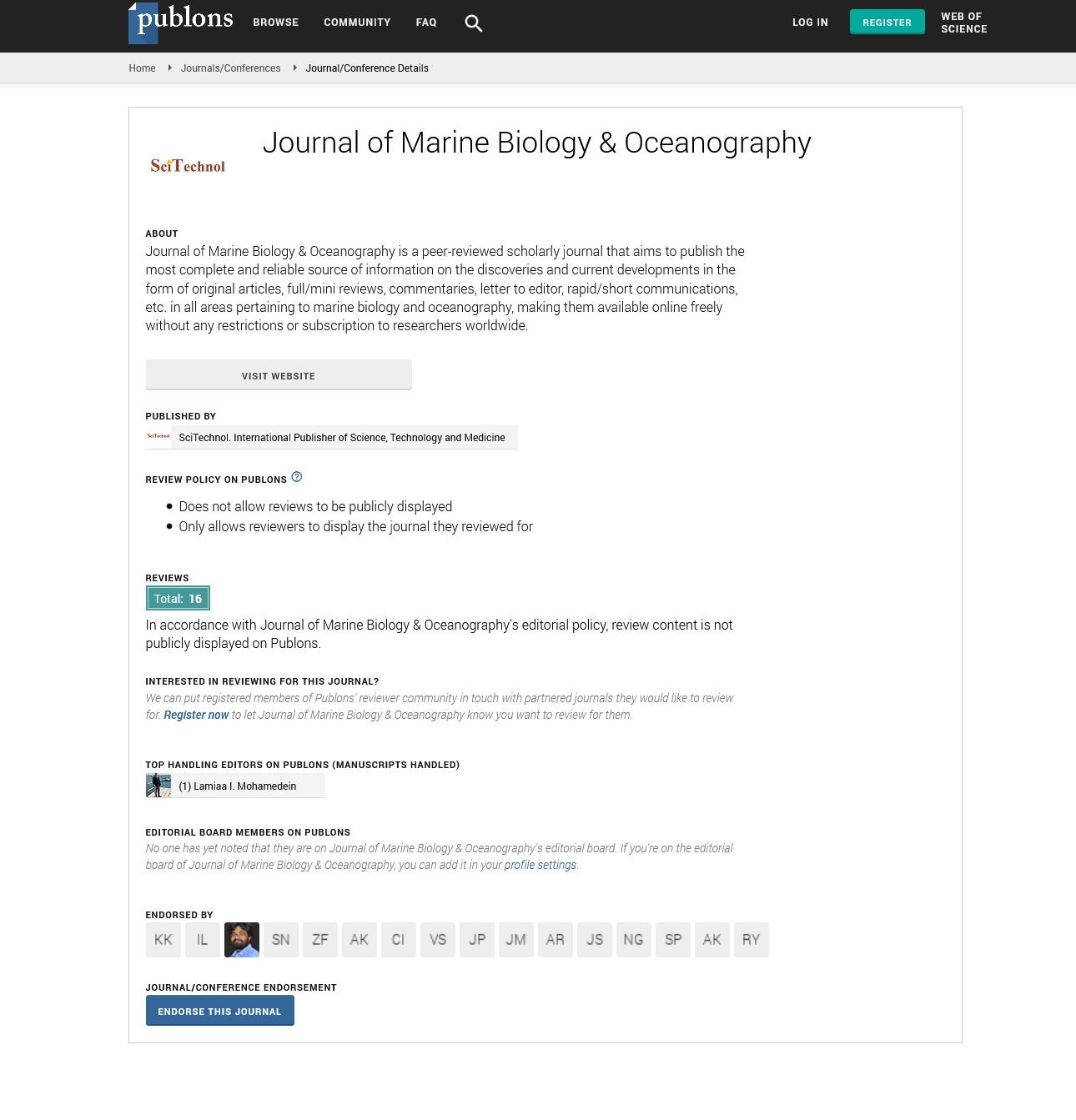Influence of different feeding frequenies on the growth, body composition and blood chemistry of juvenile mandarin fish (Siniperca scherzeir)
Kim Yi Oh , Sang-Min Lee and Sung-Yong Oh
Department of Marine Biotechnology, Gangneung-Wonju National University, Gangneung 25457, South Korea
Ulleungdo-Dokdo Ocean Research Station, Korea Institute of Ocean Science & Technology, Busan 49111, South Korea
Chungcheongbu
: J Mar Biol Oceanogr
Abstract
The spotted mandarin ï¬Âsh (Siniperca scherzeri) is one of the most commercially important freshwater endemic species in East Asia and is mainly distributed in China, Korea, and northern Vietnam (Zhou et al., 1988). Mandarin ï¬Âsh is the most promising species for inland ï¬Âsheries due to its excellent taste, high market value, rapid growth and high disease resistance (Zohreh et al., 2017). However, wild stocks of mandarin ï¬Âsh have been rapidly decreasing due to ï¬Âshing and habitat destruction, whereas commercial demand has continued to increase. Therefore, it is necessary to increase production of this species through aquaculture We investigated the effect of different feeding frequencies (1, 2, 3, or 4 meals a day) on the growth performance, body composition and blood chemistry of juvenile mandarin ï¬Âsh(Siniperca scherzeri) to determine the optimal feeding regime for commercially reared ï¬Âsh. Material and methods: Three replicate groups of ï¬Âsh (initial mean weight 7.5 g) were fed to apparent satiety with pelleted diets (55% protein) for 8 weeks. 300 juvenile mandarin ï¬Âsh(mean weight 7.5 g) were randomly distributed to 12 tanks (200 L each) with 25 ï¬Âsh per tank. Each tank was assigned to one of four feeding groups: one, two, three, or four meals a day. The feeding times were set as follows: 08:30 for the group that received one meal a day; 08:30 and 17:30 for the group that received two meals a day; 08:30, 13:00, and 17:30 for the group that received three meals a day; and 08:30, 11:30, 14:30, and 17:30 for the group that received four meals a day. The experiment was conducted using a pilot-scaled recirculation system consisting of a bioï¬Âlter tank (volume 2,000 L) and 12 FRP round rearing tanks (200 L). Results: The weight gain and speciï¬Âc growth rate of ï¬Âsh fed one meal a day were signiï¬Âcantly (p< 0.05) lower than those of ï¬Âsh fed two, three and four meals a day(Table 1). The feed efficiency of ï¬Âsh fed two meals a day was signiï¬Âcantly (p < 0.05) higher than that of ï¬Âsh fed at other frequencies. The daily feed intake was signiï¬Âcantly (p < 0.05) increased with feeding frequency, while the protein efficiency ratio signiï¬Âcantly (p < 0.05) decreased with feeding frequency(Table 2). Whole-body analysis showed that the amounts of crude protein, lipid, ash and moisture in ï¬Âsh were not signiï¬Âcantly (p > 0.05) affected by the feeding frequency. The amount of plasma cholesterol was signiï¬Âcantly (p < 0.05) lower in ï¬Âsh fed one meal a day than in those fed two, three, or four meals a day. Taken together the proper feeding frequency for the optimum growth of mandarin ï¬Âsh weighing from 7 to 20 g is two meals a day under these experimental conditions
Biography
Kim Yi Oh has completed his PhD at the age of 37 years in 2007 from Pukung University and major in aquaculture (especially, freshwater ï¬Âsh aquaculture). He is working at Chungcheongbuk-do Inland Fisheries Research Institute, Chungju, South Korea. His research interest includes mandarin ï¬Âsh, koi carp and freshwater ï¬Âsh and so on. He has published more than 15 papers in Korea and oversee reputed journals. kimio@korea.kr
 Spanish
Spanish  Chinese
Chinese  Russian
Russian  German
German  French
French  Japanese
Japanese  Portuguese
Portuguese  Hindi
Hindi 
